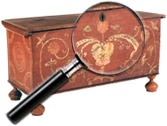|
|
William F. “Buffalo Bill” Cody
The year 1883 neatly divides William Cody’s former life as a hunter, scout and guide from his later career as a showman. He was 37 in this year of transition.
The early life of William Frederick Cody (1846 to 1917) was colorful, adventurous and, thanks to Dime novels, exaggerated. He fought for the Union Army in the Civil War at 18. By 21, he earned his lifelong nickname [...] Click here to continue reading.
Elijah Pierce (1892 to 1984)
Elijah Pierce was born on March 5, 1892 on a Mississippi farm, the son of a former slave. After receiving a pocketknife from his father, Elijah began carving. It might not have amounted to much without the guidance of his uncle, Lewis Wallace, who helped him learn the basics, like choosing the right kind of wood for a project. By the age of seven, he was carving small animals [...] Click here to continue reading.
Apocryphal – Definition
Apocryphal, the adjective form, means “of doubtful authenticity,” according to Merriam-Webster’s online dictionary. Apocrypha, the noun form, means “writings or statements of dubious authenticity,” again according to Merriam-Webster.
Apocrypha is actually a Greek word that means something closer to “obscure” or “hidden away.” The original meaning of the word, the Apocrypha in the proper noun sense, refers to religious texts outside of the traditional or accepted religious canon. Through connection with [...] Click here to continue reading.
Real Photo Postcards A real photo postcard of Annie Oakley demonstrating her shooting prowess, p4A item D9875435
Real Photo postcards are photographs that are reproduced by actually developing them onto photographic paper the size and weight of postcards, with a postcard back. There are many postcards that reproduce photos by various printing methods that are NOT “real photos”…the same methods used when reproducing photos in magazines and newspapers.
The best way to tell the [...] Click here to continue reading.
The Brooklyn Bridge
The Brooklyn Bridge is in New York City and connects the boroughs of Manhattan and Brooklyn. It was designed by John Augustus Roebling as a hybrid cable-stayed/suspension bridge. Roebling was killed in an accident just before construction started in 1869. His son Washington A. Roebling who had assisted his father in the design of the Brooklyn bridge and several other projects then took over the job of chief engineer at the [...] Click here to continue reading.
Catherine de Medici (1519 to 1589)
Born to wealthy parents, Caterina de’ Medici (1519 to 1589) was orphaned within the first month of life. Although her father was of common origins, her mother was from an ancient French noble family, so a number of European royal families were interested in arranging a marriage with her, and the decision was up to Pope Clement VII, Giulio de’ Medici. Although James V of Scotland thought he [...] Click here to continue reading.
John Singleton Mosby (1833 to 1916)
John Singleton Mosby (1833 to 1916) enlisted in a Virginia cavalry unit at the outbreak of the Civil War. He and one other in his unit were ready to re-enlist at the end of their year of service. He was head of his regiment for only two months, but long enough to get the attention of J.E.B. Stuart. Stuart invited him to serve as a scout, and throughout [...] Click here to continue reading.
General & Mrs Tom Thumb
The legendary Phineas T. Barnum was introduced to the diminutive Charles Stratton (1838 to 1883) in Bridgeport, Connecticut at the Franklin House, which his half-brother managed. From that point on Stratton was destined to become the toast of 19th century American as well as continental Europe. Stratton was granted audiences with Queen Victoria, more than one U.S. President and countless dignitaries. By mid-19th century he was truly the most [...] Click here to continue reading.
Chinese Dynastic Chronology
Note: In general, the p4A reference database uses the Pinyin naming convention system for Chinese Terminology. Where the name varies under the Wade-Giles system p4A will present that alternative in brackets. For example: Qing [or Ch'ing] Dynasty.
Neolithic Period, circa 6500 to 1700 BC
Xia Dynasty, circa 2100 to 1600 BC
Shang Dynasty, circa 1600 to 1100 BC
Zhou [or Chou] Dynasty, circa 1100 to 256 BC Western Zhou, circa 1100 [...] Click here to continue reading.
Thomas “Boston” Corbett (1832 to 1894?)
Thomas “Boston” Corbett (1832 to 1894?) was born in London, England. After immigrating to the U.S. with his family, he found work as a hatter in New York City. Because of his later erratic behavior, some have speculated that the mercury fumes caused his later problems – “mad as a hatter” has some basis in fact.
Corbett enlisted as soon as the call went out in April 1861, [...] Click here to continue reading.
|
Recent Articles
- Charles Alfred Meurer – American Artist & Tromp L’Oeil Artist
- Sendak, Maurice – American Artist & Writer
- Godie, Lee – American Artist
- Davis, Vestie – American Artist
- Bartlett, Morton – American Artist
- Mackintosh, Dwight – American Artist
- Evans, Minnie Jones – African-American Artist
- Mumma, Ed (Mr. Eddy) – American Artist
- Nice, Don – American Artist
- Savitsky, John (Jack) – American Artist
- Gordon, Harold Theodore (Ted) – American Artist
- Dial, Thornton – African-American Artist
- Doyle Sam – American Artist
- Johnson, Lester Frederick – American Artist
- Finster, Howard – American Artist
|
|
